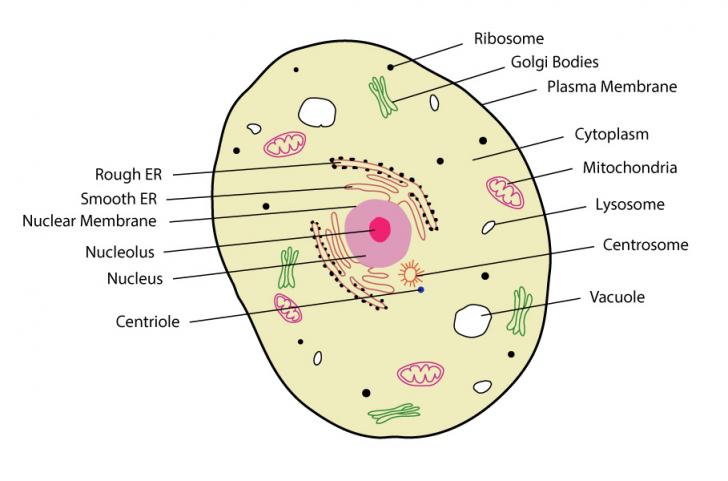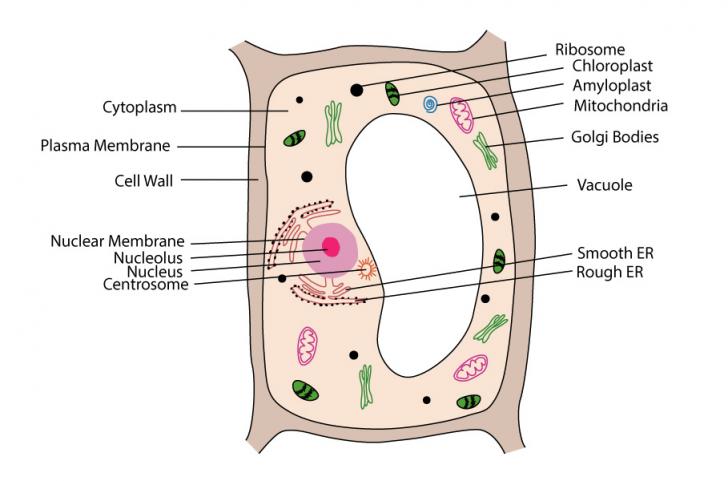More advanced and developed than the prokaryotic cell, eukaryotic cells are those which have true or membrane-bound nucleus along with other nucleus bound cell organelles.
From unicellular organisms like protozoa and amoeba, all plants and animals, including human beings are made up of eukaryotic cells.
Types of Eukaryotes
The organisms that are made up of eukaryotic cell are known as eukaryotes. These organisms are broadly divided into two categories – unicellular and multicellular, each of which are further divided into two more sub-categories.

Fungi are non-phototrophic organisms. In simple words, they are organisms which lack chlorophyll, thus incapable of using light for energy. They usually grow in dark, damp and shady places and depend upon rotten or dead organisms for fuel. Although most of the fungi like yeasts and mold are unicellular, there are others like mushroom which is multicellular.
Protista may be autotrophic (which can prepare its food itself) or heterotrophic (which depends upon other organisms for food). They are primarily found in water while some are found in moist soil too. Protista are usually unicellular but there are multicellular Protista such as kelp, algae, etc.
Plants and Animals are the most developed and popular eukaryotes. They are multicellular and have cells, more advanced, developed and complex than any other organisms.
Features of Unicellular Eukaryotes
- Unlike prokaryotes, they have well developed true nucleus and other membrane-bound cell organelles.
- They use flagella to move around the places and respond to the chemical substances present in their surrounding environment.
- They are aerobic (meaning: those who require oxygen to carry out cellular functions).
- They may reproduce sexually as well as asexually.
- Functions such as respiration, digestion, excretion, reproduction, locomotion, circulation and all others are carried out by a single cell.
- Structure and other features are more or less similar to that of the multicellular cells.
Structure


[PUT THESE IMAGES SIDE BY SIDE]
Much advanced and bigger than the prokaryotic cells, eukaryotic cells can be clearly observed under a light and electronic microscope. They have diameter ranging from 10-100µm. Eukaryotic unicellular organisms are slightly smaller than the animal cells which are even smaller than the plant cells. Almost all these cells have more or less same types of cell organelles with similar functions.
The characteristic feature of the eukaryotic cells is that they have true nucleus (a nucleus covered by a membrane called nuclear membrane). Often referred to as the brain of the cell, nucleus is the controlling unit of the cell. Inside the nucleus, is a spherical body called nucleolus which produce and distribute ribosomal subunits.
In multicellular eukaryotic cells, centrosome is present around the nucleus. It is a round organelle which interacts with chromosomes and builds mitotic spindle during mitosis. Unlike in plant cells, centrosome in animal cells is accompanied with centriole a circular body which is responsible for development of spindle fiber during the process of cell division.
All eukaryotic cells have vacuoles. They are empty space or bubble found in the cytoplasm which helps in storing foods and other nutritional substances. It also stores waste products in order to prevent contamination in the cell.
Vacuole is single and is much larger in plant cells while they are small and can be found in multiple numbers in animal cells. Vacuoles being larger in plant cells, lysosomes are often absent. Lysosomes are membrane bound organelle whose major function is to digest or degrade waste and other excessive particles in the cell. They also digest engulfed cells like bacteria and viruses. Food vacuoles play similar role in the unicellular eukaryotic cells.
Multicellular eukaryotic cells also have mitochondria, ribosome, Golgi bodies and endoplasmic reticulum. Mitochondria are double layered organelles which are the site for biochemical respiration while ribosomes are complex molecule of RNA-protein which synthesizes protein.
Golgi bodies, on the other hand, are the composite of vestibules and folded membranes whose major function is to absorb and store lipids, proteins and certain enzymes while Endoplasmic reticulum produces molecules according to the need of the cell and carries out translation.
Cell organelles like chloroplast and amyloplast are found only in eukaryotic plant cells. Chloroplast is a colored pigment which conducts photosynthesis while amyloplast is a non-pigmented organelle which synthesizes starch granule from polymerization of glucose. Similarly, organelles like contractile vacuoles, pseudopodia and cilia are present in unicellular eukaryotic cells; they conduct osmoregulation, locomotion and movement in liquid, respectively.
All the cell inclusions are held in place by the semi-fluid called cytoplasm. The cytoplasm in unicellular organisms like amoeba is divided into two types – the inner, granulated one as endoplasm and the outer non-granulated one as ectoplasm. Cytoplasm of all eukaryotic cells is surrounded by the lipid layer called plasma membrane. Distinctive from all, plant cells are surrounded with cell wall. It is protective layer which is made up of cellulose, hemicellulose, carbohydrate, protein and pectic substances.
Reproduction
It is the characteristic feature of eukaryotic cell that it reproduces sexually. But, it can also reproduce asexually. Asexual reproduction is often referred to as cell division and it occurs through mitosis. On the other hand, sexual reproduction occurs through meiosis.
Mitosis
Mitosis is a process of cell division in which a mother nucleus is divided into two identical daughter nuclei. It is completed in 5 stages – prophase, premetaphase, metaphase, anaphase and telophase.
Mitosis occurs whenever more cells are needed. More cells are required for growth and development of newly born organs or to repair damaged part of organs. In plant cell, mitosis cell division can be observed in root tips, new leaves, cambial cells of stems, etc. Similarly, in animal cells, it occurs mostly in skin cell.
Meiosis
Meiosis occurs in almost all eukaryotes of higher level like plants and animals. In animals, meiosis occurs in spermatogonial and oogonial cells; they produce sperms and eggs, respectively. In plants, meiosis occurs in anthers and in ovary to produce pollen grains and ovules, respectively.